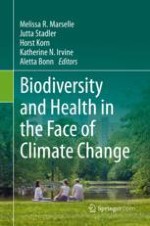Open Access 2019 | Open Access | Book

Biodiversity and Health in the Face of Climate Change
Editors: Melissa R. Marselle, Jutta Stadler, Dr. Horst Korn, Dr. Katherine N. Irvine, Dr. Aletta Bonn
Publisher: Springer International Publishing
Open Access 2019 | Open Access | Book

Editors: Melissa R. Marselle, Jutta Stadler, Dr. Horst Korn, Dr. Katherine N. Irvine, Dr. Aletta Bonn
Publisher: Springer International Publishing
This open access book identifies and discusses biodiversity’s contribution to physical, mental and spiritual health and wellbeing. Furthermore, the book identifies the implications of this relationship for nature conservation, public health, landscape architecture and urban planning – and considers the opportunities of nature-based solutions for climate change adaptation.
This transdisciplinary book will attract a wide audience interested in biodiversity, ecology, resource management, public health, psychology, urban planning, and landscape architecture. The emphasis is on multiple human health benefits from biodiversity - in particular with respect to the increasing challenge of climate change. This makes the book unique to other books that focus either on biodiversity and physical health or natural environments and mental wellbeing. The book is written as a definitive ‘go-to’ book for those who are new to the field of biodiversity and health.